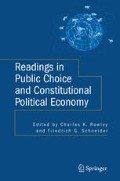Anthony Downs’ An Economic Theory of Democracy (Downs, 1957) is one of the founding books of the Public Choice movement, and one of the most influential social science books of the twentieth century. It has been reprinted and continuously in print (with the exception of a handful of months) for 50 years. Citations to it now surpass that of any other book on American electoral politics, including such classics as Campbell et al.’s The American Voter (1960), which laid the foundations for the behavioral approach to the study of voter behavior that has come to be associated with the University of Michigan (Gray and Grofman, 2005). Downs’ book introduced seminal ideas, such as a cost-benefit calculation of political participation, a spatial model of party competition, knowledge about public affairs as a by-product of other more directly instrumental activities, and concepts such as rational ignorance and cue-taking behavior. While Downs has written more than a dozen other books since 1957, the sum of all this work has not come close to the influence of his first book, and our discussion will focus on this work.
An Economic Theory of Democracy was Downs’ doctoral dissertation in economics at Stanford, and was published without any changes. Several political scientists who read it, including scholars such as Robert Dahl, recognized its innovation and importance, and after being shown the work by Dahl, Charles Lindblom, whom Downs had never met, arranged for three different publishers to offer Downs contracts for its publication (Downs, 1993). Yet, at the time of its publication no one could have truly anticipated its long-run impact on the political science discipline. Remarkably, too, it is largely an accident that Downs wrote on the topic he did, rather than on the political economy of expressways (Downs, 1993). Downs was encouraged to switch dissertation topics by scholars such as Julius Margolis, who introduced Downs to the writings of Joseph Schumpeter, and by his thesis supervisor, Kenneth Arrow (Downs, 1993).
This is an original paper written specifically for this book.
Access this chapter
Tax calculation will be finalised at checkout
Purchases are for personal use only
Preview
Unable to display preview. Download preview PDF.
References
Adams, J., Merrill, S., and Grofman, B. (2005). A Unified Theory of Party Competition: A CrossNational Analysis Integrating Spatial and Behavioral Factors. New York: Cambridge University Press.
Brennan, G., and Hamlin, A. (1998). ‘‘Expressive voting and electoral equilibrium,’’ Public Choice, 108, 295-312.
Downs, A. (1957). An Economic Theory of Democracy. New York: Harper and Row.
Downs, A. (l993). ‘‘The Origins of ‘An Economic Theory of Democracy’.’’ In Bernard, G. (Ed). Information, Participation and Choice: An ‘Economic Theory of Democracy’ in Perspective. Ann Arbor: University of Michigan Press, pp. 179-193.
Glazer, A., Grofman, B., and Owen, G. (1998). ‘‘A neo-Downsian model of group-oriented voting and racial backlash.’’ Public Choice, 97, 23-34.
Grant, D. (1998). ‘‘Searching for the Downsian voter with a simple structural model.’’ Economics and Politics, 10(2), 107-126.
Gray, M. M. and Grofman, B. (2005). ‘‘Vindicating Anthony downs.’’ Political Science and Politics, 38(4), 737-740.
Green, D. P. and Shapiro, I. (1994). Pathologies of Rational Choice Theory: A Critique of Applications in Political Science. New Haven, CT: Yale University Press.
Grofman, B. (Ed.). (l993). ‘‘Is turnout the paradox that ate rational choice theory’’ In Information, Participation and Choice: An ‘Economic Theory of Democracy’ in Perspective. Ann Arbor: University of Michigan Press, 93-103.
Hanks, C. and Grofman, B. (1998). ‘‘Turnout in gubernatorial and senatorial primary and general elections in the South, 1922-90: A rational choice model of the effects of short-run and longrun electoral competition on turnout.’’ Public Choice, 94, 407-421.
Morton, R. (1991). ‘‘Groups in rational turnout models,’’ American Journal of Political Science, 35,758-76.
Owen, G. and Grofman, B. (1984). ‘‘To vote or not to vote: The paradox of nonvoting.’’ Public Choice, 42, 311-325.
Uhlaner, C. (1989). ‘‘Rational turnout: The neglected role of groups.’’ American Journal of Political Science, 33(2), 390-422.
Author information
Authors and Affiliations
Rights and permissions
Copyright information
© 2008 Springer Science + Business Media, LLC
About this chapter
Cite this chapter
Grofman, B. (2008). Anthony Downs (1930 - ). In: Readings in Public Choice and Constitutional Political Economy. Springer, Boston, MA. https://doi.org/10.1007/978-0-387-75870-1_6
Download citation
DOI: https://doi.org/10.1007/978-0-387-75870-1_6
Publisher Name: Springer, Boston, MA
Print ISBN: 978-0-387-74574-9
Online ISBN: 978-0-387-75870-1
eBook Packages: Business and EconomicsEconomics and Finance (R0)

